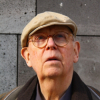Claes Oldenburg

Claes Oldenburg
Claes Oldenburgis an American sculptor, best known for his public art installations typically featuring very large replicas of everyday objects. Another theme in his work is soft sculpture versions of everyday objects. Many of his works were made in collaboration with his wife, Coosje van Bruggen. Van Bruggen died in 2009 after 32 years of marriage. Oldenburg lives and works in New York...
NationalitySwedish
ProfessionSculptor
Date of Birth28 January 1929
CityStockholm, Sweden
CountrySweden